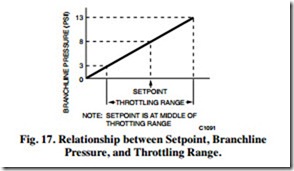THERMOSTATS
Thermostats are of four basic types:
— A low-capacity, single-temperature thermostat is the basic nozzle-flapper bleed-type control described earlier. It is a bleed, one-pipe, proportional thermostat that is either direct or reverse acting.
— A high-capacity, single-temperature thermostat is a low- capacity thermostat with a capacity amplifier added. It
is a pilot-bleed, two-pipe, proportioning thermostat that is either direct or reverse acting.
— A dual-temperature thermostat typically provides occupied/unoccupied control. It is essentially two thermostats in one housing, each having its own bimetal
sensing element and setpoint adjustment. A valve unit controlled by mainline pressure switches between the occupied and unoccupied mode. A manual override lever
allows an occupant to change the thermostat operation from unoccupied operation to occupied operation.
— A dual-acting (heating/cooling) thermostat is another two-pipe, proportioning thermostat that has two bimetal sensing elements. One element is direct acting for heating control, and the other, reverse acting for cooling control. Switchover is the same as for the dual-temperature thermostat but without manual override.
Other thermostats are available for specific uses. Energy con- servation thermostats limit setpoint adjustments to reasonable minimums and maximums. Zero energy band thermostats provide an adjustable deadband between heating and cooling operations.
The thermostat provides a branchline air pressure that is a function of the ambient temperature of the controlled space and the setpoint and throttling range settings. The throttling range setting and the setpoint determine the span and operating range of the thermostat. The nozzle-flapper-bimetal assembly maintains a fixed branchline pressure for each temperature within the throttling range (Fig. 17). The forces within the nozzle-flapper-bimetal assembly always seek a balanced condition against the nozzle pressure. If the setpoint is changed, the forces in the lever system are unbalanced and the room ambient temperature must change in a direction to cause the bimetal to rebalance the lever system.
For example, if the setpoint of a direct acting thermostat is increased, the bimetal reduces the force applied to the flapper and raises the flapper off the nozzle. This movement causes the branchline pressure to bleed down and a heating valve to open. Heat enters the space until the temperature at the thermostat increases and the force of the bimetal is again in equilibrium with the opposing force of the pressure at the nozzle. Decreasing the setpoint causes the reverse to occur.
The throttling range adjustment provides the means for changing the effective length of the cantilever bimetal in the lever system. When the throttling range adjustment is positioned directly over the nozzle, the force of the bimetal increases and a narrow throttling range or very high sensitivity could result in a branchline pressure change of 5 psi.
When the throttling range adjustment is moved toward the end of the bimetal and away from the nozzle, the force of the bimetal is reduced. This reduction requires a greater temperature change at the bimetal to throttle the flapper over the nozzle. The result is a wider throttling range or very low sensitivity. For example, a temperature change of 1 degree F could result in a branchline pressure change of only 1 psi.
